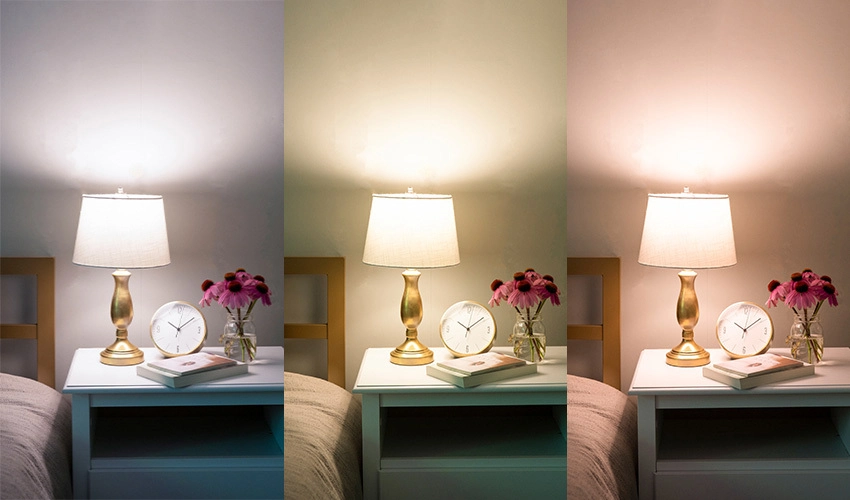
Five Star Painting explains how lighting impacts paint color choices and room ambiance.
|
Painting your walls is a great way to recharge your home’s atmosphere, but choosing the right color can be tricky.
Understanding how lighting affects paint color can help ensure a happy end result.
One of the variables you should manage when choosing your new color is how the paint's look will change as the light in the room changes.
Here's what we mean: Have you ever put on a pair of socks only to discover later under different lighting that your socks are actually two different colors? The technical term for this phenomenon is illuminant metamerism. It simply means that colors may take on different hues when viewed under different light. This is an important consideration because, for example, the cool, new shade that you love at the paint store might not look as great as expected on your dining room walls. Or maybe it looks fantastic in your dining room but has a little too much pop in the family room. Tricky, right?
Illuminant metamerism may not be the biggest deal in the world when it comes to socks, but when it comes to painting your home's interior, it can matter a lot!
Hues may also vary throughout the day as light conditions change from morning to night. Knowing how lighting affects paint color before you impulse purchase gallons of paint can help you choose your palette wisely.
How Sunlight Affects Paint Colors
Natural light that streams through your windows displays the truest representation of colors, for better or worse. That's why colors often appear different on your walls than they did under the store's fluorescent bulbs.
When choosing paint colors, consider the size and number of windows, as well as their directional placement:
Southern-facing windows typically provide the most intense natural light, which can be harsh on sunny afternoons. Pale colors and whites might seem to be faded or dull, while darker colors may appear brighter.
- Rooms with north-facing windows provide indirect natural light, infusing the space with a warm, soft tone that remains more consistent throughout the day. Dark colors often appear darker and light colors may be slightly muted. (Note: If you live in the southern hemisphere, the reverse is true: north windows provide more intense light, while south windows provide indirect natural lighting.)
- Windows that face east may flood your room with lots of natural light in the mornings but are typically darker later in the day. Dark colors will appear intense in the bright, morning light, but may have a drab effect as the morning light fades.
- West-facing rooms, while darker in the morning, are bathed in rich yellow or golden tones of the late afternoon. Red or yellow colors may become overwhelming on bright, sunny days.
Every home has its own unique lighting patterns that will affect interior colors. Other factors to think about include the climate you live in and seasonal light fluctuations. Ideally, colors should be appealing to you under a variety of different lighting conditions. Another tip to consider is your geographical location. The further north you go, the bluer the light becomes, with longer wavelengths. Some paint consultants feel this can really affect the way a color will appear. They say that light appears redder in the south, with shorter wavelengths. Some of the off-whites, like Kilim Beige SW 6106 really pick up on this. They can even reflect light from the green on the trees or the red on the deck stain, changing it, like a chameleon!
How Artificial Lighting Affects Paint Colors
To understand how artificial lighting affects paint colors when it comes from a bulb instead of the sun, it helps to know some basic light bulb terminology. Color temperature, which is measured in Kelvins, rates color tones. Typically, household bulbs are rated from 2,700K to 5,000K. Lower temperatures (2,700K to 3,000K) indicate warmer tones, like those of typical incandescent bulbs. Higher temperatures bulbs emit cool tones. A 5,000K bulb is comparable to natural daylight.
The CRI (color rendering index) is another means of rating bulbs. Bulbs typically rate from 50 to 100 on the index. A higher rating indicates that the bulb produces a more accurate representation of color when compared to natural light.
Check the color temperature and CRI of your household bulbs to help determine how room lighting may affect your paint colors. Typically, under bulbs with higher color temperatures, dark colors will look brighter, and light colors may seem to appear washed out. Paint colors will be closer to their true representation under bulbs with the highest CRI ratings.
Preview Before Painting!
What’s the best way to see whether a color is really the perfect fit for your walls? There are two good options:
Paint swatches in a few places on each wall before making a final decision. (These can easily be painted over once you choose your colors.)
An even better option it to paint a small square (3' x 3') of drywall, which you can place throughout the room to see how the paint color changes in different areas.
Choose a time when you can spend at least one full day at home to view the swatches in varying lighting conditions. Ideally, pick a day when the sun will be shining so you can see how it affects the color.
Another good idea: paint your swatches the night before so they’ll be fully dry first thing in the morning on observation day.
Think about the time of day when a room typically gets the most use, and pay special attention to how colors appear during those times. If you really like a color, but there are certain times of the day when it’s a little off, think about ways to change the lighting. With natural light from windows, you may be able to adjust the flow of light with curtains or blinds. If the problem lies with indoor lighting, experiment with different types of bulbs to see how they change the hue.
Get Help from an Expert
Have you been thinking about giving your walls a makeover, but not sure you have the time or the expertise to do the job right? Five Star Painting is ready to help! From helping you choose the right colors to professional application, we’ve got you covered. Leave the painting—and the cleanup—to us! Call or visit online to request a free estimate.


